 The December 1981 issue of Pro Wrestling Illustrated typifies the realistic and graphic (in my opinion, erotic) presentation of violence that was common in the rasslin’ magazines of the 1970’s and 80’s.
The December 1981 issue of Pro Wrestling Illustrated typifies the realistic and graphic (in my opinion, erotic) presentation of violence that was common in the rasslin’ magazines of the 1970’s and 80’s.
The cover features young Tommy Rich in a painful armbar, beautifully smooth and shirtless with his feminine blond hair spilling down to his shoulders, his legs spread open to our view.
His attacker stands over him with biceps flexed to emphasize his ardent dominance as the caption questions whether poor Tommy will even “survive” this encounter. The inset photo reveals a mysterious man wearing a kinky fetish mask and silver boots coupling with another shirtless male in red trunks. How could you NOT shell out the mere $1.50 needed to take this promising publication home and really devour it??
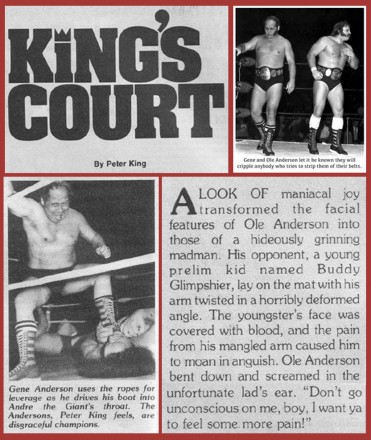 The first article (which I’ve chopped up and re-created here with some added photos) is an expose’ on the sadistic Anderson brothers — Ole and Gene. The story opens with the brothers in the middle of demolishing some jobber (or “prelim kid“) — the unfortunate Buddy Glimpshier.
The first article (which I’ve chopped up and re-created here with some added photos) is an expose’ on the sadistic Anderson brothers — Ole and Gene. The story opens with the brothers in the middle of demolishing some jobber (or “prelim kid“) — the unfortunate Buddy Glimpshier.
Glimpshier’s agony is graphically detailed for our reading pleasure: his face is “covered with blood” and his arm “horribly deformed.” After hearing the young man “moan in anguish,” his relentless attacker informs the “boy” that he is not finished with him yet.
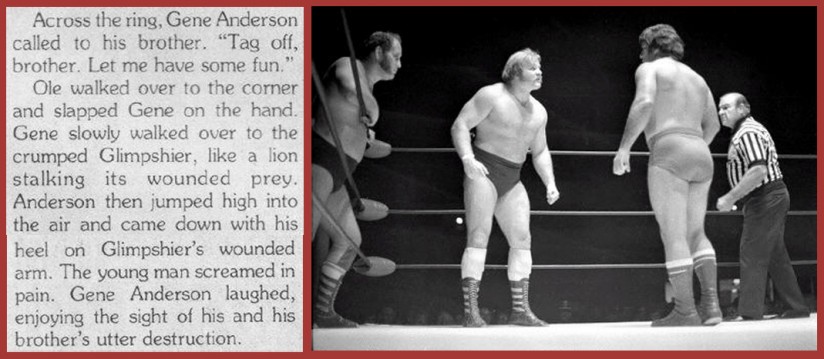 The Anderson brothers are presented as a pair of sadists, experiencing “maniacal joy” from the torture they’re inflicting. Watching from the Heel’s corner, Gene begs for his chance to get in the ring and “have some fun” — as if they’re raping poor Glimpshier! We are also informed that Gene Anderson “enjoyed the sight” of their bloodied and injured victim — which implies he really, really enjoyed it — like maybe he got off on it if you catch my drift.
The Anderson brothers are presented as a pair of sadists, experiencing “maniacal joy” from the torture they’re inflicting. Watching from the Heel’s corner, Gene begs for his chance to get in the ring and “have some fun” — as if they’re raping poor Glimpshier! We are also informed that Gene Anderson “enjoyed the sight” of their bloodied and injured victim — which implies he really, really enjoyed it — like maybe he got off on it if you catch my drift.
Next, we are told: “the Andersons continued to take turns pummeling the helpless young man.” Your interpretation of that sentence depends on whether you define “pummel” in the traditional dictionary sense or by the word’s more modern (and prurient) meaning.
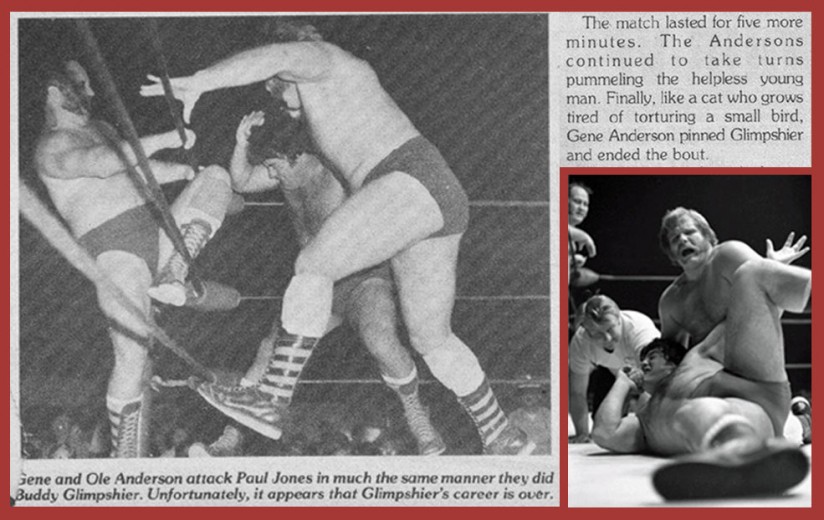
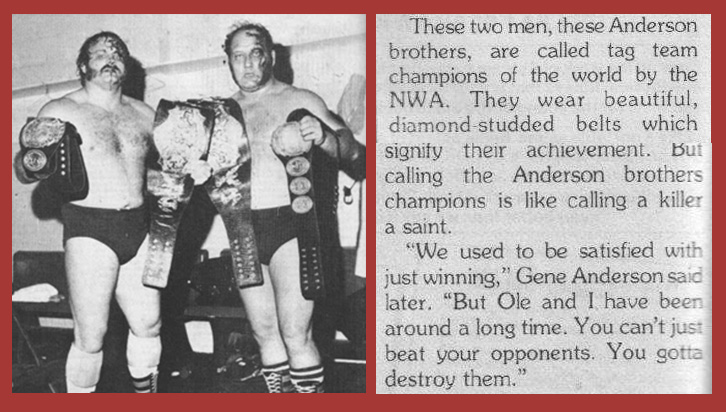
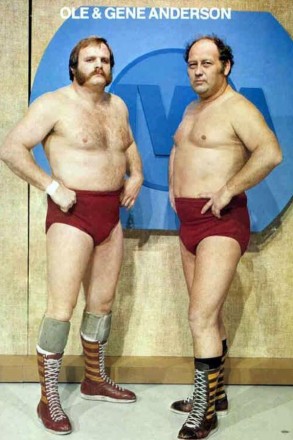 Normally the stories in Pro Wrestling Illustrated were paired with images that would further “illustrate” the wrestling match that the writer is describing. However, no photos of the “utter destruction” of Buddy Glimpshier are presented here.
Normally the stories in Pro Wrestling Illustrated were paired with images that would further “illustrate” the wrestling match that the writer is describing. However, no photos of the “utter destruction” of Buddy Glimpshier are presented here.
Were the photos of Glimpshier’s “horribly deformed arm” too sickening to reveal? If he was so terribly wounded, why didn’t the officials stop the bout? And where is Glimpshier’s partner (not even named in the article as if Glimpshier agreed to take on both Anderson brothers alone)?
To find some answers to these pressing questions, I googled “Buddy Glimpshier” but found absolutely no hits — no historical record of anyone by that name…
So I am calling Shenanigans on this whole article and the mysterious Buddy Glimpshier! Pro wrestlers get their arms twisted and bent, but almost never suffer serious injury with the possibility of losing a limb (as claimed later in the article). And when have you ever seen a squash match where the jobber’s face gets bloodied? This is unlikely — blading was usually reserved for the really big feuds by the top superstars, a ploy to inject extra drama into the Main Event. And when does a squash match continue “for five more minutes” after the jobber already was helpless and injured? Most squashes are barely over five minutes in total!
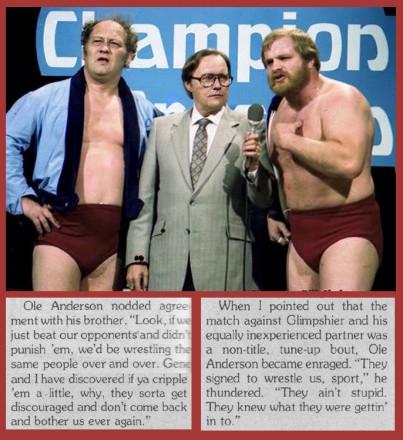 The two-on-one beating of Buddy Glimpshier was apparently a fairy tale for grown men– a fantasy of violence and brutality meant to titillate the reader and to glorify the masculine might of the beefy Anderson men.
The two-on-one beating of Buddy Glimpshier was apparently a fairy tale for grown men– a fantasy of violence and brutality meant to titillate the reader and to glorify the masculine might of the beefy Anderson men.
Masculinity is treated here as a fetish — we are invited to drool over the savage caveman antics and thick bodies of the Andersons. Glimpshier is a weakling, so his injury of little concern (and his impotent partner outside the ring is barely mentioned.)
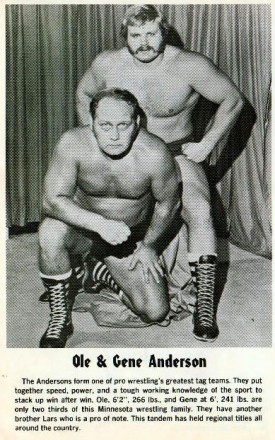 The writer repeatedly draws our attention to the Alpha Males — the big, unbeatable Andersons. They are the protagonists in the story, the male leads whose actions propel the narrative (in contrast to the passive and therefore feminine Buddy Glimpshier who is not even given a voice, outside of his endless moaning).
The writer repeatedly draws our attention to the Alpha Males — the big, unbeatable Andersons. They are the protagonists in the story, the male leads whose actions propel the narrative (in contrast to the passive and therefore feminine Buddy Glimpshier who is not even given a voice, outside of his endless moaning).
The gory description of the Andersons’ cruel attack is not meant to vilify them, but rather to glorify their power and strength — to give the reader a boner for them. The article is a primer on “How to Act Like a Real Man” circa 1981. The reader is meant to understand that success in pro wrestling (and life in general) depends upon you acting strong, ruthless, and stoic — in other words, of being masculine. And if another man bothers you, you should “cripple ’em a little” to ensure his submission.
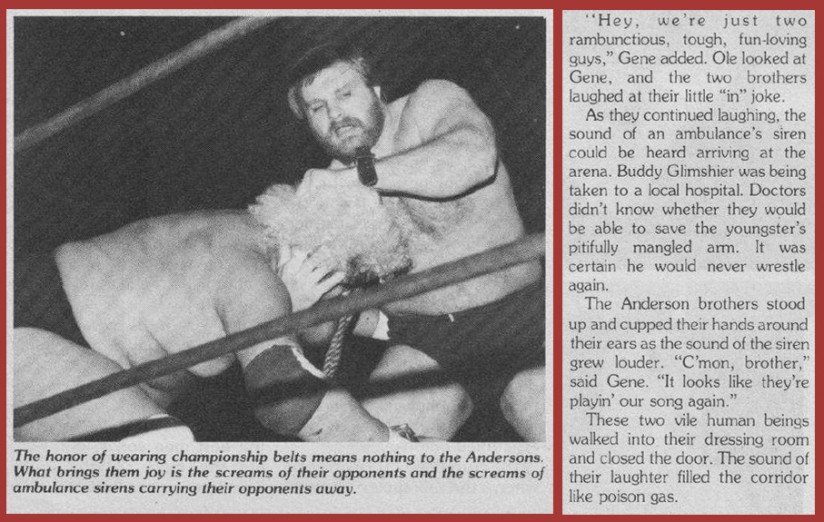 The two “tough, fun-loving” Andersons laugh as an ambulance arrives to take away poor Buddy Glimpshier (or, as he is called in this paragraph, “Glimshier” without the “p“. Apparently the “p” was beaten out of him!)
The two “tough, fun-loving” Andersons laugh as an ambulance arrives to take away poor Buddy Glimpshier (or, as he is called in this paragraph, “Glimshier” without the “p“. Apparently the “p” was beaten out of him!)
But most strangely, the final two paragraphs of the story seem to imply a bizarre homo-sexual (and incestuous) encounter between the uber-masculine Andersons. Hearing the sirens, Gene remarks that “they’re playin’ our song,” which is normally a comment stated between two long-time lovers of the opposite sex (just before they get it on). Then, the two Alpha Males walk to their dressing room together as if they’re walking off into the sunset and, the article notes, “closed the door.”
This phrase leads the reader to question what is going on behind that door — why did they pointedly block the reporter’s view — and therefore our view — of whatever is happening in the privacy of their dressing room? The reporter can only hear “the sound of their laughter,” which leads us to understand that the Andersons are quite satisfied with each other’s masculine behavior and what they did to Glimpshier earlier in the evening. Apparently, they fulfill one another no matter how “vile” the rest of us find their behavior. Each Anderson is apparently very pleased (to the point of laughing, of experiencing maniacal joy) with the other Anderson. This re-confirms to the reader that the ultimate relationship in pro wrestling (and by extension, in life) is the male homo-social relationship.
